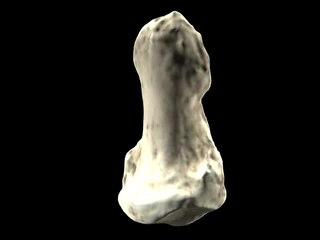
Orrorin is an extinct genus of primate within Homininae from the Miocene Lukeino Formation and Pliocene Mabaget Formation, both of Kenya.

The Colobinae or leaf-eating monkeys are a subfamily of the Old World monkey family that includes 61 species in 11 genera, including the black-and-white colobus, the large-nosed proboscis monkey, and the gray langurs. Some classifications split the colobine monkeys into two tribes, while others split them into three groups. Both classifications put the three African genera Colobus, Piliocolobus, and Procolobus in one group; these genera are distinct in that they have stub thumbs. The various Asian genera are placed into another one or two groups. Analysis of mtDNA confirms the Asian species form two distinct groups, one of langurs and the other of the "odd-nosed" species, but are inconsistent as to the relationships of the gray langurs; some studies suggest that the gray langurs are not closely related to either of these groups, while others place them firmly within the langur group.

The Tugen Hills are a series of hills in Baringo County, Kenya. They are located in the central-western portion of Kenya.

Victoriapithecus macinnesi was a primate from the middle Miocene that lived approximately 15 to 17 million years ago in Northern and Eastern Africa. Through extensive field work on Maboko Island in Lake Victoria, Kenya, over 3,500 specimens have been found, making V. macinnesi one of the best-known fossil primates. It was previously thought that perhaps multiple species of Victoriapithecus were found, however the majority of fossils found indicate there is only one species, V. macinnesi. Victoriapithecus shows similarities to the extant subfamilies Colobinae and Cercopithecinae. However, Victoriapithecus predates the last common ancestor of these two groups and instead is thought to be a sister taxon.

Pachycrocuta is an extinct genus of prehistoric hyenas. The largest and most well-researched species is Pachycrocuta brevirostris, colloquially known as the giant short-faced hyena as it stood about 90–100 cm (35–39 in) at the shoulder and it is estimated to have averaged 110 kg (240 lb) in weight, approaching the size of a lioness, making it the largest known hyena. Pachycrocuta first appeared during the late Miocene. By 800,000 years ago, it became locally extinct in Europe, with it surviving in East Asia until at least 500,000 years ago, and possibly later elsewhere in Asia.

Mesopithecus is an extinct genus of Old World monkey belonging to the subfamily Colobinae that lived in Europe and Asia during the Late Miocene and Pliocene epochs, around 8.2-2.6 million years ago. Fossils span from Great Britain and the Iberian Peninsula in the west, eastwards to the Indian Subcontinent and China. Species of Mesopithecus had a body length of about 40 centimetres (16 in), possessing a slender body with long, muscular limbs and flexible fingers. Analysis of its anatomy suggests that members of the genus were semiterrestrial, spending a considerable amount of the time on the ground, though some authors have argued that some species were likely arboreal. Species of Mesopithecus were likely capable climbers and probably occasionally engaged in leaping. Dental microwear analysis suggests that it fed on hard seeds as well as probably leaves. The relationship of Mesopithecus to living members of Colobinae is uncertain, some have interpreted it as an early offshoot outside the split between Asian and African colobines, while others have interpreted it as a close relative of the Asian doucs (Pygathrix).
Chororapithecus is an extinct great ape from the Afar region of Ethiopia roughly 8 million years ago during the Late Miocene, comprising one species, C. abyssinicus. It is known from 9 isolated teeth discovered in a 2005–2007 survey of the Chorora Formation. The teeth are indistinguishable from those of gorillas in terms of absolute size and relative proportions, and it has been proposed to be an early member of Gorillini. However, this is controversial given the paucity of remains, and notable anatomical differences between Chororapithecus and gorilla teeth. The Kenyan ape Nakalipithecus has been proposed to be an ancestor of Chororapithecus or at least closely related. If correct, they would be the only identified fossil members of any modern non-human great ape lineage, and would push the gorilla–human last common ancestor from 8 million years ago to 10 million years ago. The teeth are adapted for processing tough plant fibres as well as hard, brittle food, and the formation is thought to represent a forested lakeside habitat.

Nakalipithecus nakayamai, sometimes referred to as the Nakali ape, is an extinct species of great ape from Nakali, Kenya, from about 9.9–9.8 million years ago during the Late Miocene. It is known from a right jawbone with 3 molars and from 11 isolated teeth. The jawbone specimen is presumed female as the teeth are similar in size to those of female gorillas and orangutans. Compared to other great apes, the canines are short, the enamel is thin, and the molars are flatter. Nakalipithecus seems to have inhabited a sclerophyllous woodland environment.

Paracolobus is an extinct genus of primate closely related to the living colobus monkeys. It lived in eastern Africa in the Pliocene and Early Pleistocene. Fossils have been found in Kenya and Ethiopia, in places such as the Omo valley.
Simiolus is an extinct genus of dendropithecid primates. It was described by Mary Leakey and Richard Leakey in 1987, and the type species is S. enjiessi, which existed during the Miocene of Kenya. The species epithet is a phonetic pun on the acronym NGS. A new species, S. andrewsi, also from the middle Miocene of Kenya, was described by Terry Harrison in 2010. In November 2018, scientists reported the discovery of the smallest known ape, Simiolus minutus, which weighed approximately 8 lb (3.6 kg), and lived about 12.5 million years ago in Kenya in East Africa.

Enhydriodon is an extinct genus of mustelids known from Africa, Pakistan, and India that lived from the late Miocene to the early Pleistocene. It contains nine confirmed species, two debated species, and at least a few other undescribed species from Africa. The genus belongs to the tribe Enhydriodontini in the otter subfamily Lutrinae. Enhydriodon means "otter tooth" in Ancient Greek and is a reference to its dentition rather than to the Enhydra genus, which includes the modern sea otter and its two prehistoric relatives.

Cercopithecoides is an extinct genus of colobine monkey from Africa which lived during the latest Miocene to the Pleistocene period. There are several recognized species, with the smallest close in size to some of the larger extant colobines, and males of the largest species weighed over 50 kilograms (110 lb).

Epipliopithecus vindobonensis is an extinct species of pliopithecoid primate recovered from the Middle Miocene deposits of Devínska Nová Ves fissure in western Slovakia. Epipliopithecus is one of the few pliopithecoids for which both cranial and post-cranial fossil material has been recovered. Most pliopithecoids are known only from fossilized teeth, whereas Epipliopithecus is known from three nearly complete skeletons. As such, Epipliopithecus has greatly informed the modern understanding of pliopithecoid anatomy, locomotion, and phylogeny.
The Nyanzapithecinae or Nyanzapithecines are a subfamily of extinct Dendropithecidae as sister of Simiolus. The group contains Rangwapithecus, Turkanapithecus, Rukwapithecus, Oreopithecus, and Nyanzapithecus. In the following tree the internal structure of Nyanzapithecinae of Nengo et al. is followed.
Micropithecus is an extinct genus of primates that lived in East Africa about 19 to 15 million years ago, during the early Miocene. The genus and its type species, Micropithecus clarki, were first scientifically described in 1978.
Rhinocolobus is an extinct genus of monkey closely related to modern colobus monkeys. It lived in eastern Africa during the Plio-Pleistocene, existing as recently as 1.5 million years ago.

Dolichopithecus is an extinct genus of Old World monkey that lived in Europe during the Late Miocene and Pliocene.
Asilifelis is an extinct genus of small felid that lived in what is now Kenya during the Early Miocene. Despite its fragmentary remains, it is remarkable because of its small size and advanced dentition. It contains a single species, Asilifelis cotae.
The Lukeino Formation is a geologic formation located in Kenya and it dates to the Late Miocene (Messinian).
Sawecolobus is an extinct genus of colobine primate that inhabited Kenya during the Late Miocene, containing the species Sawecolobus lukeinoensis.















